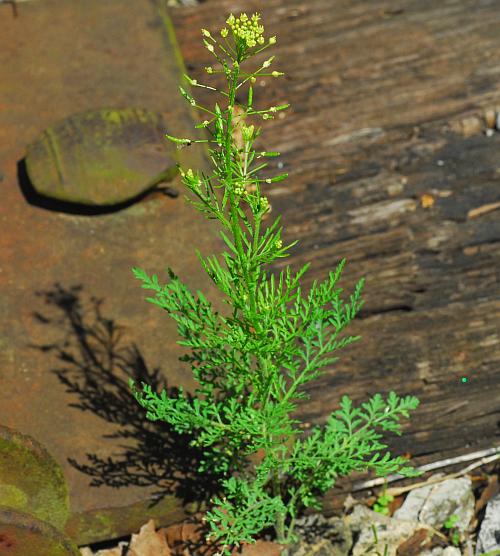Descurainia pinnata (Walter) Britton
Tansy Mustard

Native
CC = Amb
CW = 5
MOC = 76
© SRTurner
Descurainia pinnata (Walter) BrittonTansy Mustard | |
 |
Native CC = Amb CW = 5 MOC = 76 |
© SRTurner |
|
Family - Brassicaceae Habit - Annual or biennial forb. Stem - Erect, 25-50 cm long.
Leaves - Alternate, pinnately compound, short petiolate or sessile. Blades 1-10 cm long, 2 or 3 times pinnately dissected, the leaflets toothed and oblanceolate to linear, the upper leaves progressively reduced and less divided.
Inflorescences - Racemes or less commonly panicles, the flowers often not subtended by bracts.
Flowers - Sepals 4, lanceolate to ovate, ascending to erect, 1-2 mm long. Petals 4, 1.0-3.5 mm long, pale yellow. Styles absent or less than 0.5 mm long.
Fruits - Club-shaped or oblong, 5-10 mm long, 1-2 mm wide, blunt at the tip, the valves with 1 midnerve. Styles 0.1-0.2 mm. Seeds 10-40 per fruit, at least in part in 2 rows in each locule.
Flowering - March - July. Habitat - Forest openings, streambanks, bluffs, glades, prairies, railroads, fields, open disturbed areas. Origin - Native to the U.S. Lookalikes - D. sophia. Other info. - This native mustard is common throughout Missouri, and also across the western 2/3 of the continental U.S. It is easily recognized by its small yellow flowers arranged in the mustard pattern, and its highly dissected foliage. The appearance is similar to the introduced flixweed, Descurainia sophia, but that species has much longer, narrower fruits. Photographs taken at Hickory Canyons Natural Area, Ste. Genevieve County, MO, 5-1-2010, near St. Albans, Franklin County, MO, 4-18-2011 and 4-1-2012, Weldon Spring Conservation Area, St. Charles County, MO, 4-6-2012 (SRTurner). |